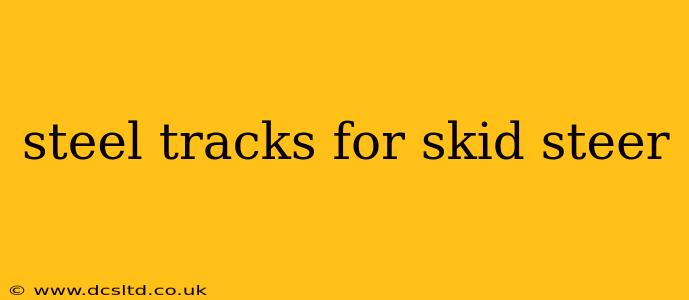Skid steer loaders are incredibly versatile machines, but their limitations on certain terrains are well-known. Soft ground, mud, snow, and steep inclines can quickly hinder productivity. This is where steel tracks for skid steers shine. Converting your skid steer to tracks dramatically increases its capabilities, opening up new opportunities and improving efficiency. This guide dives into everything you need to know about steel tracks for skid steer loaders.
What are Steel Tracks for Skid Steers?
Steel tracks replace the standard rubber tires on a skid steer, providing significantly increased traction and stability. These tracks consist of steel components, offering superior durability compared to rubber tracks, especially in harsh conditions. They distribute the weight of the machine over a larger surface area, reducing ground pressure and minimizing soil compaction. This makes them ideal for sensitive environments and challenging terrains.
Why Choose Steel Tracks Over Rubber Tracks?
While rubber tracks offer certain advantages, steel tracks excel in specific situations:
- Superior Durability: Steel tracks are far more resistant to punctures, tears, and abrasions than rubber tracks, making them a longer-lasting investment, especially in rocky or abrasive environments.
- Increased Pulling Power: The robust construction of steel tracks provides exceptional pulling power, allowing for easier movement of heavy loads and operation on steep inclines.
- Greater Stability: The wider contact patch of steel tracks provides unmatched stability, especially on uneven or slippery surfaces. This translates to enhanced safety and control.
What are the Different Types of Steel Tracks?
Steel tracks for skid steers aren't all created equal. Several factors differentiate them:
- Width: Track width impacts ground pressure and stability. Wider tracks reduce ground pressure but can limit maneuverability.
- Length: Longer tracks generally offer smoother operation and improved traction, particularly on uneven terrain.
- Material: While most are steel, variations in the steel alloy affect durability and wear resistance.
- Design: Different designs offer various benefits; some prioritize durability, others maneuverability.
How Much Do Steel Tracks for Skid Steers Cost?
The cost of steel tracks varies significantly based on factors like size, brand, and features. Expect to invest a substantial amount, significantly more than rubber track systems. However, the longevity and increased capability often justify the higher upfront cost.
How to Install Steel Tracks on a Skid Steer?
Installation typically requires some mechanical aptitude. While some manufacturers offer user-friendly systems, professional installation is often recommended, particularly for larger or more complex track systems. Consulting with a qualified mechanic or your skid steer dealer is advisable.
Are Steel Tracks Right for My Skid Steer?
Steel tracks are a significant investment, so careful consideration is vital. Evaluate your operational needs; if you frequently work in challenging terrains or require maximum traction and pulling power, steel tracks may be a worthwhile investment. However, if your work primarily involves paved surfaces or relatively smooth terrain, the added expense may not be justified.
What are the Maintenance Requirements for Steel Tracks?
Steel tracks require regular maintenance to ensure longevity and optimal performance. This includes routine inspections for wear and tear, lubrication, and addressing any damage promptly. Following the manufacturer's recommended maintenance schedule is crucial.
What are the Advantages and Disadvantages of Steel Tracks Compared to Rubber Tracks?
Advantages:
- Superior Durability: Much longer lifespan than rubber tracks in harsh conditions.
- Increased Traction: Provides excellent grip in mud, snow, and other challenging terrains.
- Higher Load Capacity: Can handle heavier loads with greater stability.
Disadvantages:
- Higher Cost: Significantly more expensive than rubber tracks.
- Increased Weight: Adds considerable weight to the skid steer.
- Reduced Maneuverability: Can be less maneuverable than rubber tires, especially in tight spaces.
How Long Do Steel Tracks for Skid Steers Last?
The lifespan of steel tracks depends heavily on usage, terrain, and maintenance. Under optimal conditions, they can last significantly longer than rubber tracks, potentially several years. However, harsh operating environments can reduce their lifespan.
This comprehensive guide should help you make an informed decision regarding steel tracks for your skid steer. Remember to always consult your skid steer's owner's manual and a qualified mechanic for specific advice tailored to your machine and intended use.
